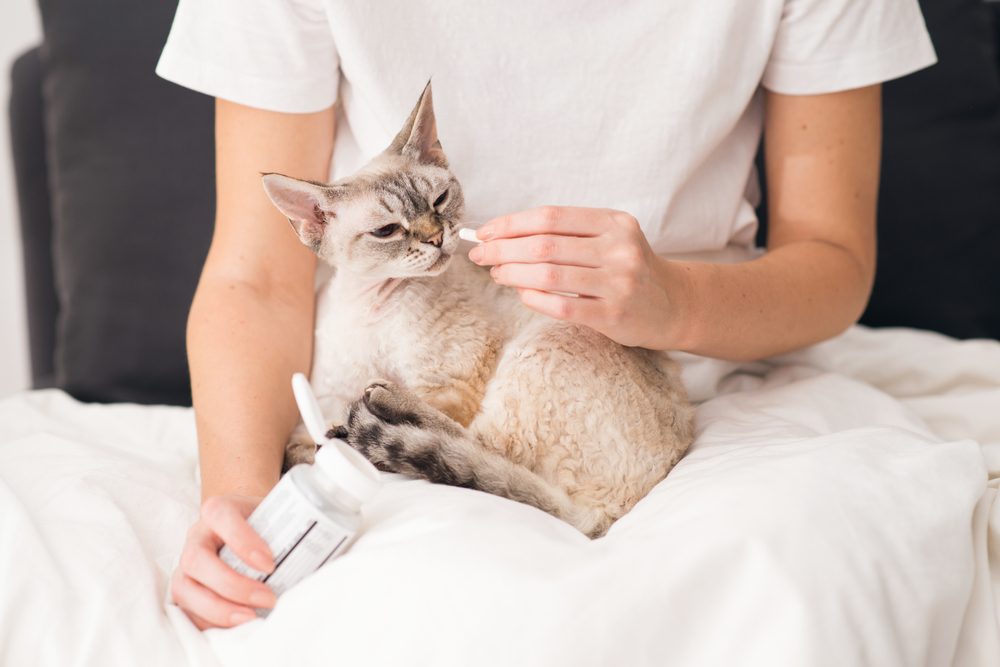Many pet owners find that medicating their pet can be a huge challenge. Whether the medication form is a pill, liquid, or topical treatment, many pets resist medications because they are unfamiliar substances or because they are stressed. However, you can employ various strategies to make the process smoother for you and your pet. Our Midtown Veterinary Hospital team offers pro tips for administering pet meds without the stress.
Using treats and pill pockets for pet medications
One of the most effective ways to medicate your pet is to use disguise with pill pockets. These soft, flavored treats have a built-in space where you hide the pill, seal the pocket, and then feed it to your pet as a regular treat.
Tips for using pill pockets or treats:
- Choose a flavor your pet loves, such as chicken or beef.
- Ensure the treat is big enough to completely conceal the pill or capsule.
- Monitor your pet and check that they’ve entirely ingested the medication. Pets are masters at spitting out a pill when you’re not looking.
Mixing pet medication with food or water
If your furry friend is particularly resistant to pills, you can try crushing and mixing the pill with a small amount of wet food or tuna. This method works well for food-motivated pets who don’t mind the altered taste.
Tips for mixing medication with food or water:
- Always check with our Midtown Veterinary Hospital team, as some medications should not be crushed or taken with food.
- Use a strong-smelling food to mask the medication.
- Administer the medication during your pet’s regular mealtime, so they assume it’s their standard breakfast or dinner.
- Ensure your pet consumes the entire portion and gets the total required dose. You can make this easier by mixing the medication with the first half of your pet’s food, and then the rest of their normal meal with no medication.
Administering liquid medication to your pet
Liquid medication can sometimes be easier to administer than pills and to ensure the correct dosage. Some pets will happily swallow liquid medicines dispensed through a syringe. Resistant pets are less likely to detect liquid medication that’s mixed with their food or with tuna juice or chicken broth.
Tips for giving liquid medication:
- Measure the correct dose with a syringe.
- Tilt your pet’s head back and squirt the liquid into the side of their mouth, aiming toward the back.
- If our veterinarian OKs that the medication can be mixed with food, add the liquid to a small amount of wet food, broth, or tuna water.
- Reward your pet with a treat or affection immediately.
Applying topical medications to your pet
Topical medications, such as creams, ointments, or spot-on treatments, are applied directly to the skin or fur and can be a good option for pets who are difficult to medicate orally.
Tips for applying topicals:
- Follow the instructions carefully regarding application site and amount per application.
- Use disposable gloves to prevent your skin from contacting the medication.
- Part the fur, if necessary, and apply the topical directly to the skin.
- Prevent your pet from licking the medication by distracting them with a treat or toy until it dries, or using an Elizabethan collar (E-collar).
Consult with our veterinarian

If you’re struggling to medicate your pet, don’t hesitate to contact our veterinarian. We can offer alternative medication forms, such as flavored compounding, or provide additional tips and techniques, such as positive reinforcement, that will help your pet accept their medicine. Many pets will become less resistant over time.
Medicating your pet doesn’t have to be a stressful experience. Work out which treatment form (i.e., pill, liquid, or topical) your pet prefers, use positive rewards (i.e., treats and praise), and the medication process will be easier and more pleasant. Contact our Midtown Veterinary Hospital team if you need help finding the best method for ensuring your pet takes their medicine.






Leave A Comment